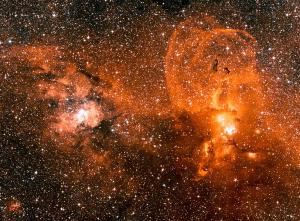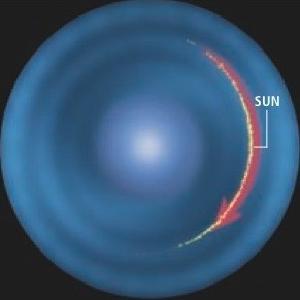Blog
Siblings
6 April 2014
 NASA, ESA, and the Hubble Heritage
NASA, ESA, and the Hubble HeritageStars don’t form alone. They form as part of a stellar nursery. We know this because we can see new stars forming in this way, such as in the Orion nebula. This means, of course, that our own Sun also formed in a stellar nursery with lots of other stars. There are stars out in the galaxy that are siblings to our Sun, and we think we know where a few of them are.
You might think stars close to the Sun, like Alpha Centauri, are likely siblings, but that turns out not to be the case. The Sun formed about 5 billion years ago, and stars of a stellar nursery tend to disperse in random directions, so many of the Sun’s siblings are likely quite far away. But it is possible that some solar siblings are relatively close. If we assume that the Sun’s stellar nursery formed about 1,000 stars (which seems somewhat typical), then by one estimate about 10 siblings would be within 400 light years of the Sun, and about 100 within 4000 light years. Other studies argue this might be too optimistic, but it at least seems feasible that a handful of solar siblings could be relatively close by.
 Don Dixon
Don DixonOf course the trick is to identify them. To be a candidate sibling, a star needs to satisfy three conditions. First, it must be of similar age to the Sun. Second, it must have a similar metallicity, meaning the ratio of various elements (relative to hydrogen and helium) must be similar to the ratio found in the Sun. Third, it must have a trajectory that would allow it to have been in a similar region of the Sun 5 billion years ago.
This would seem to be more difficult than finding a needle in a haystack, but with large sky surveys the task is somewhat more tractable. As outlined in a recent paper in Astronomy and Astrophysics,1 we now have five candidate siblings, including one found by this team.
The team searched through HARPS data to find candidate stars. HARPS (High Accuracy Radial-velocity Planet Searcher) was a projected designed to look for exoplanets by measuring the wobble of the parent star, but to measure that wobble (radial velocity) you need a precise measurement of a stars spectrum. The team analyzed the spectrum to determine the metallicity and age of more than a thousand stars. The HARPS data also provided information on the trajectories of these stars. From this they were able to discover a new candidate sibling.
As we make larger and more precise surveys of the Milky Way, such as the one planned for the Gaia satellite, we are likely to find even more siblings of our Sun. This will help us further understand just how our Sun came to be.
Batista, S. F. A., et al. “Searching for solar siblings among the HARPS data.” Astronomy & Astrophysics 564 (2014): A43. ↩︎